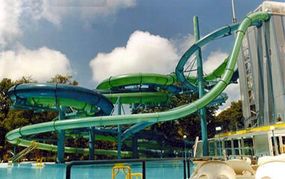Types of Water Slides, from Sleds to Serpentines
The slide applies a force working against gravity. The balance of these two forces depends on the angle of the slide. When you are sliding along on a nearly level slope, gravity pulls you directly into the slide, and the slide pushes you upward. The upward force of the slide pushes nearly opposite the downward force of gravity, slowing your downward acceleration. When the slope drops sharply, gravity is still pulling you straight down, but the slanted slide is no longer pushing you straight up; it's pushing you at an angle between upward and forward. Since the slide isn't working directly against gravity, you accelerate downward more rapidly.
Speed slides and sled slides focus only on these up-and-down forces. On a speed slide, you plummet straight down a steep slope and launch into an exit flume, a long canal of water that slows you down gradually. In a sled slide (also called a toboggan slide), you glide over a series of bumps and dips. In both of these slide designs, you move forward in a straight line.
Advertisement

Serpentine slides add something new to the mix: curves. The slide snakes around on its way to the bottom, whipping you in different directions all the while. In this sort of ride, the slide structure is not only working against the force of gravity, it's working against your own inertia. When you speed toward a curve, your body naturally wants to keep going forward. If the slide were flat, you would be launched into the air at the first sharp turn. The slide has to curve up at these turns to keep you on the ride.
When you hit these curves, you feel a strong force acting on your body. This is the slide accelerating you — changing your forward velocity — so you move in a different direction. (See How Roller Coasters Work to find out more about these forces.)
For everything to work correctly in a waterslide, you need a sturdy, smooth surface to glide on. In the next section, we'll look at the structural elements of waterslides.
